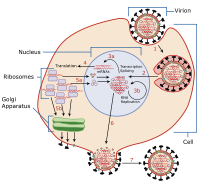
Back تناثر فيروسي Arabic ウイルス排出 Japanese 바이러스 배출 Korean Excreção viral Portuguese Вирусовыделение Russian Viral çıkış Turkish
| Influenza virus life cycle |
|---|
 |
Viral shedding is the expulsion and release of virus progeny following successful reproduction during a host cell infection. Once replication has been completed and the host cell is exhausted of all resources in making viral progeny, the viruses may begin to leave the cell by several methods.[1]
The term is variously used to refer to viral particles shedding from a single cell, from one part of the body into another,[2] and from a body into the environment, where the virus may infect another.[3]
Vaccine shedding is a form of viral shedding which can occur in instances of infection caused by some attenuated (or "live virus") vaccines.
- ^ N.J. Dimmock et al. "Introduction to Modern Virology, 6th edition." Blackwell Publishing, 20hif ilikr 07.
- ^ Massachusetts Department of Public Health – Rabies Control Plan – Chapter 1: General Information – "Definitions as Used in this Document [...] Shedding – The release of rabies virus from the salivary glands into the saliva."[dead link]
- ^ Hall CB, Douglas RG, Geiman JM, Meagher MP (October 1979). "Viral shedding patterns of children with influenza B infection". The Journal of Infectious Diseases. 140 (4): 610–3. doi:10.1093/infdis/140.4.610. PMID 512419.